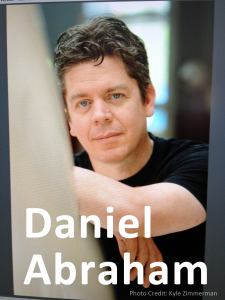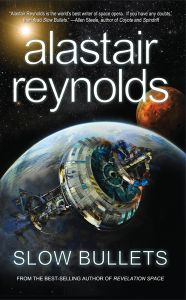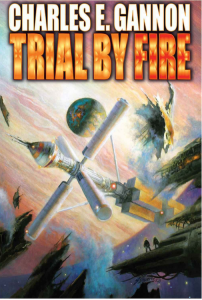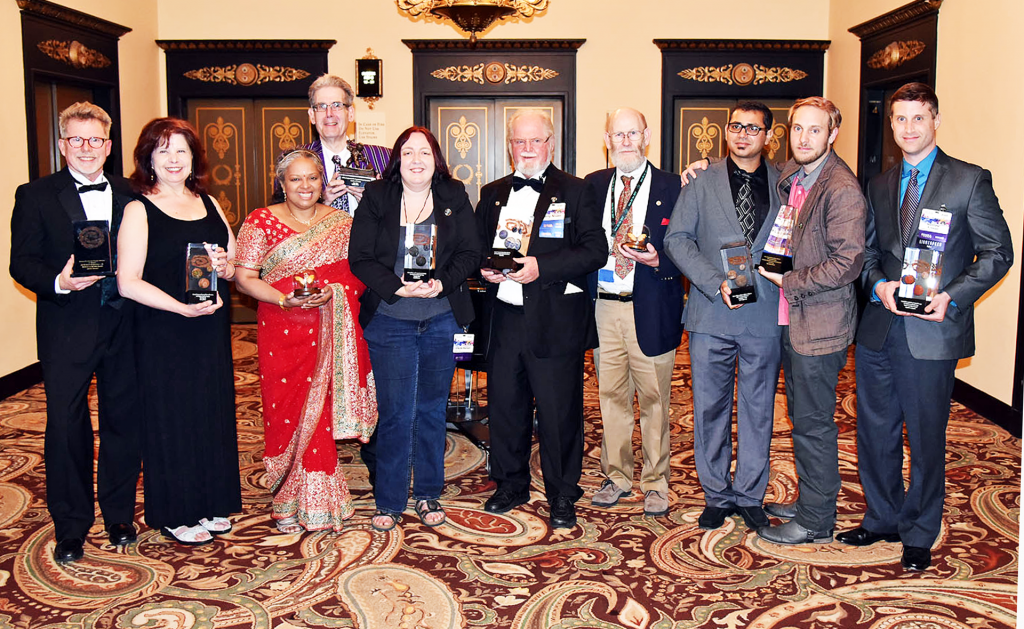 SFRevu: Let me apologize up front for doing an interview with you which is mostly going to be about The Expanse, since you’re only half of James S.A. Corey. On the other hand, since I’m primarily an sf reader and don’t pursue a lot of fantasy, getting hooked on the Long Price Quartet was a real bonus.
SFRevu: Let me apologize up front for doing an interview with you which is mostly going to be about The Expanse, since you’re only half of James S.A. Corey. On the other hand, since I’m primarily an sf reader and don’t pursue a lot of fantasy, getting hooked on the Long Price Quartet was a real bonus.
Daniel Abraham: Not a problem. I’m happy to talk about any of it.
SFRevu: How did The Expanse come about? Every hero needs an origin story, so What’s this one?
Daniel: Well, we went to see Zorro one night, and on the way home there was this mugger, and… No, hold on. Wait.
My entry into the project was playing in a table-top role playing game that Ty Franck was running. It was really well-researched, with a lot of depth. The kind of thing where I could ask what the walls looked like or where the processing systems came together or how the banks worked, and he knew. It was this massive amount of world-building that had gone on, and I thought it would be a great setting for a novel. So I suggested we collaborate on a novel set there for fun. Apparently he thought it’d be cool too.
SFRevu: James S.A. Corey is the fusion of you and Ty Frank, though if you two are the brains, I suspect that there’s actually a whole village of people that might be considered vital organs. Who does what, and what do you do when you disagree … if you ever do?
Daniel: We very rarely disagree. There were a lot of conversations early in the process about what the project was. That helped a lot. Since we were both aiming toward the same thing, those times when we have seen things differently were pretty easy to negotiate. We looked at which one would be better at getting us to the kind of book we said we wanted. In case of a tie, we go for the one that looks most amazing when you picture it. We’ve never had a deep disagreement about the direction of the project.
SFRevu: In The Expanse, you achieve a level of physics, planetary science and biotech that would be respectable in something by Kim Stanley Robinson. Where does all that come from?
Daniel: Ty did a lot of background work for the table top game, and I have a degree in biology. We also know a lot of people whose expertise we can call upon if we need it for a particular issue.
SFRevu: My favorite science, which you handle very nicely both in your fantasy and The Expanse, is the dismal science, though in your stories, economics isn’t dismal at all, but provides a depth to the conflicts that most people miss. How did that evolve for you as a storyteller, and is there anyone else out there that you think does a good job with it?
Daniel: Ah, economics. I came to economics late in life, and with the zeal of a convert. I didn’t actually take any coursework in it when I was in college, so almost everything I learned was from books like Naked Economics by Charles Wheelan or one of Timothy Taylor’s lecture series on it. Or NPR’s Planet Money podcast. So I found this toolbox of analytical ideas that were made to look at how people acted and how the narrative of money and value are assigned and interact, and it was great.
I tend to divide the world into things that are discovered (rocks, laws of physics, stars) and things that are created (buildings, money, narratives of justice). I’d spent a lot of time in my intellectual career looking at things that are discovered, and economics was one of the first really extensive toolkits I found for thinking about things that are created.
It’s not an easy thing to incorporate into fiction, but it’s brilliant when it works. David Liss comes to mind as someone who did fiction really well with that. For non-fiction, though, there are some very surprising, wonderful books. Tim Parks is a novelist and writer about place. His book-length essay Medici Money is great. I’ve read it three of four times. And there’s a book called Payback: Debt and the Shadow side of Wealth that’s worth looking at to. That one’s by Margaret Atwood.
SFRevu: How much of you is in James Holden? Going over your Reddit chat from last year a couple things popped out that sounded very much like him, including, “You can ask me anything. Most of the time I won’t lie.” and “I had sex too early and grew a conscience too late.” That sounds like Holden to me.
Daniel: Some, but Ty writes the first drafts of the Holden chapters. My writing voice varies a lot depending on the project, but there are certainly personal choices and styles that just happen because all this stuff’s coming out of the same head.
SFRevu: One of the consistent themes in The Expanse seems to be the business of giving the job to the guy who you know won’t get it done, except that he does. I love the bit when someone explains to Miller that he’s “that guy” and he realizes that it’s what he’s become. Even Holden gets tapped for the role in Cibola Burn, though annoying anyone who tries to manipulate him is his charm. Is that just a reliable trope, or is it something you have a stake in? Got any favorite examples from movies or other novels?
Daniel: I think that’s a tool that a lot of people – myself included – can relate to. Who hasn’t felt like they were in over their head on something, right? Or had that “holy shit, I got away with it” thing when it actually worked out. Everyone suffers imposter syndrome at some point. That’s just a story that literalizes those fears and emotions.
For my money, the best version of that was Robert B. Parker’s Night Passage. That was his first Jesse Stone novel, and the way he built Jesse’s personal failures and the underestimation of those around him into the plot itself was great.
SFRevu: Here we are on Book #5, The Nemesis Games, which is the best book so far, in my opinion. I loved having so many characters from the other books show up, especially Sgt. Bobbie Draper, who Alex describes as “the woman with the power armor” when he’s too out of it to think straight. But I miss Miller, and I wonder how Prax is getting on. Any chance you could drop a hint?
Daniel: Prax is doing really, really well. He’s been working on the rebuilding of Ganymede, both as a researcher and – partly because he became a kind of minor celebrity – as an administrator. Mei’s doing well too. There are a lot of characters in The Expanse who come in, tell their story, and then their story’s done. We don’t see Prax again because he’s having adventures that aren’t very dramatic, and involve things like getting .3% better yield on a new strain of soybean and allocating the budget in a way that keeps as many projects as possible on track. It’s important, fascinating work for him, but it’s not much for us to watch.
Miller, on the other hand, is dead.
(Ern – Never stopped him before.)
SFRevu: Now that filming the first season of The Expanse is over, what do you think of the job they’ve done?
Daniel: I think they’re freaking brilliant. It has been a pleasure and an honor to work with these folks at remaking the story we told in the books, and watching how the things we did resonated and reformed in minds with new, different skill sets and aesthetic insights. There are so many profoundly talented people involved in this – writers, directors, actors, the guy who keeps us on budget, the visual effects team, the artists, the makeup folks, the construction crews that made the sets – the depth of expertise that goes into a project like that is insane and awe inspiring. I think they’ve done a really great job.
SFRevu: What was the working dynamic between James S.A. Corey and the other writers like Mark Fergus and Hawk Ostby?
Daniel: It’s a little eerie sometimes. Mark and Hawk particularly have a working dynamic as a team that makes perfect sense to me and Ty. Of everyone involved in this I think Mark and Hawk have the story sensibility that’s most like ours. But there are a lot of people who are also involved and amazing who don’t. We’ve got scripts in the first season by Robin Veich who wrote for Mad Men and Dan Nowak from The Killing and Jason Ning who was on Burn Notice and Perception. And our other showrunner, Naren Shankar who’s been part of Star Trek TNG and CSI and Farscape. Everyone has a different style and set of strengths and perspectives. And they make a great team.
SFRevu: I’m sure there are lots of folks hoping that The Expanse will fill the void left by Firefly. Are you a fan of any other space opera or science fiction series?
Daniel: Yeah, I don’t think we’re going to fill the void left by anyone else. I mean, I’m probably too close to it, but it doesn’t look or feel to me like anything I’ve seen before. It’s too much itself. As to my fandoms, they are many and varied. My wife and I watched all of Cowboy Bebob, and I grew up on Star Trek and the ’73 Tomorrow People. And all the Alien movies whether they were good or not. And now the Marvel Cinematic Universe. And Firefly. And Orphan Black. And The Hitchhiker’s Guide to the Galaxy (which I first found as radio drama on my local college station). And the Mass Effect games, and the Deus Ex games. And that’s intentionally leaving out all the books.
So yeah. A few, I guess.
SFRevu: Reading the Long Price Quartet, it is clear you have fantasy under your spell. So it seems odd that space opera, and hard space opera at that, seems to be your forte…but it totally is. A friend of mine says that the two of you write as though you live in those worlds—both of them–and I agree. How hard is it to shift gears? How is writing for the two genres different?
Daniel: It’s not really harder than switching genres or projects in reading. It’s a different set of characters in a different set of circumstances, but the tools of writing stay the same, and the essential humanity that I’m at least trying to reach for doesn’t move around much. I think the biggest thing is that there’s a shift in diction that comes with fantasy and space opera. Le Guin talked about it in her essay From Elfland to Poughkeepsie – the kind of using intentionally archaic or formal-sounding language to help evoke a particular kind of relationship to the present. Space opera doesn’t have that as much, because we are all tacitly in its past – or at least we are in the stuff I’m writing. But really, it’s not hard.
SFRevu: I’d imagine you’re pretty busy with the series and the show, and the occasional blockbuster Star Wars tie in. Do you have any time left for writing fantasy? What’s Daniel Abraham up to these days?
Daniel: Well, I’m actually still finishing up the last Dagger and Coin book, The Spider’s War. After that, I’m not sure what the epic fantasy projects are that I’m looking at. I may go play in the field next door for a little while. I’ve got a crime novel I’d like to try, and Vandermeer’s Southern Reach books have convinced me there’s still something interesting to do with cosmic horror. But if I find the right epic fantasy and something I want to say in that genre, I’ll pick it back up. I’d particularly like to try writing some one-volume stories. I’ve done a lot of books, but surprisingly few in that format.
SFRevu: And because you are both clearly creative geniuses in your own rights, what became of the game Ty Frank was developing?
Daniel: We sold all the rights to Alcon Entertainment. Ty’s been doing some work in video games, though. He was part of the team that put together Telltale’s Game of Thrones serialized game.
SFRevu: I understand that your decision to be a full-time writer had more to do with being able to help out with childcare and support your gal’s career than the expectation of becoming a household name. How’s that working out for you? Or should I ask?
Daniel: It’s going really well. My wife’s finished up a fifteen-year long clinical career as an occupational therapist, and she’s in graduate school now. The kid’s discovering videogames and Terry Pratchett novels. And I’m pretty sure I’m going to be able to keep things afloat with the writing until neither of them need tuition.
Because Obamacare. Seriously.
Links / References
- Speculative Fiction Database; Daniel Abraham; http://www.isfdb.org/cgi-bin/ea.cgi?10297
- Author’s Blog: Lizard Brain; http://www.danielabraham.com/
- Daniel Abraham’s Expanse Page; http://www.danielabraham.com/books-2/the-expanse/
- Peter Orullian’s Interview with Danil Abraham: 2012-01-31; http://orullian.com/writing/danielabraham_interview.html
- Apex Magazine, 2013-04-02; http://www.apex-magazine.com/an-interview-with-daniel-abraham/
- Clarkesworld Interviw by Tobias Bucknell; DATE???; http://clarkesworldmagazine.com/abraham_interview/
- Orbit Books; An Interview With Daniel Abraham on THE DRAGON’S PATH; http://www.orbitbooks.net/interview/daniel-abraham/
- Reddit.com; Hi, Reddit! I’m NYT Bestselling Fantasy & SF Author Daial Abraham…; http://www.reddit.com/r/Fantasy/comments/1glrwq/hi_reddit_im_nyt_bestselling_fantasy_sf_author/
- Wikipedia; The Expanse; http://en.wikipedia.org/wiki/The_Expanse_%28TV_series%29
- Variety; The Expanse; http://variety.com/t/the-expanse/
- MTV; Bubonicon; Long Prince Quartet; Video Interview; http://www.mtv.com/videos/interview/690608/bubonicon-43-daniel-abrahams-long-price-quartet.jhtml
- IMDB; The Expanse; http://www.imdb.com/title/tt3230854/
 When a new Alistair Reynolds novel comes out, fans can be confident that it’s going to be Space Opera of the highest quality, with a mix of propulsive plot and thought-provoking commentary on life, the universe, civilization. and the human condition. They can also expect that it’s going to take more than a few pages to do it’s job. Sometimes a few more pages than you might have time for.
When a new Alistair Reynolds novel comes out, fans can be confident that it’s going to be Space Opera of the highest quality, with a mix of propulsive plot and thought-provoking commentary on life, the universe, civilization. and the human condition. They can also expect that it’s going to take more than a few pages to do it’s job. Sometimes a few more pages than you might have time for.
 Before Tomorrowland is more or less a prequel to Tomorrrowland, the movie, but you’ll have a hard time matching up the threads between them. Of course, some of them wound up on the cutting room floor, but even so, it’s lacking as a prequel. The action takes place around the first Worldcon and the1939 New York World’s Fair, when a secret society of scientists, the Plus Ultra gang, prepares to unveil the existence of a world of tomorrow, today. Somehow they discovered a fantastic world just a wormhole, or something away, and are keen to build the kind of techno-utopia that science fiction fans have been dreaming of.
Before Tomorrowland is more or less a prequel to Tomorrrowland, the movie, but you’ll have a hard time matching up the threads between them. Of course, some of them wound up on the cutting room floor, but even so, it’s lacking as a prequel. The action takes place around the first Worldcon and the1939 New York World’s Fair, when a secret society of scientists, the Plus Ultra gang, prepares to unveil the existence of a world of tomorrow, today. Somehow they discovered a fantastic world just a wormhole, or something away, and are keen to build the kind of techno-utopia that science fiction fans have been dreaming of.
